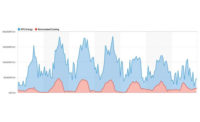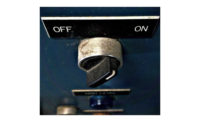Embracing your coworkers’ knowledge and experience in each of their respective roles allows a company to thrive. Rapidly changing supply chains, the constant push for more secure networks, and evolving energy efficiency-related infrastructure requirements demand building professionals become solutions experts, not just workers getting paid to do a job. Proactive is better than reactive, and it’s wise to never forget we are being trusted to be the experts.
One service call can lead to opportunities across the entire organization. Many times, a call starts as a simple, “I’m too hot,” or “I’m too cold.” The importance of having a friendly and knowledgeable person answering that call is imperative. While this person does not have to be a diagnosis expert, their ability to funnel that call to the appropriate person, along with having an understanding of the problem, is extremely worthwhile. The person answering the phone typically becomes the voice of the company, and how they handle that initial call can set up the rest of the team to be efficient and successful.
When you operate with a team mindset, these service calls become office conversations by the afternoon and may then lead to opportunities. Why? Because the rest of the team wants to solve problems. For example, the call might be a simple variable air volume (VAV) damper repair. Now imagine if you let curiosity lead you to a bigger solution. Start by asking, “If one damper is wrong, how many more have a similar issue?” The service tech might mention, “Even after I fixed it, I still seemed to not be getting enough air in the space.” Before the end of the day, a sales manager or service manager might reach out and ask the customer for permission to explore further with the analytics team, and now the building blocks are in place to being the journey to building efficiency.
We would suggest that especially in the new operating environment, where remote work is the new normal, the ability to monitor and control a building’s HVAC and lighting systems is even more paramount. Building efficiency is not a one-time event; it’s a journey and a process. This process must be repeated over and over again with improvements and setbacks. How do you get there, and what might this process look like?
As we’ve described, it can start with a simple service call. The building engineer or the technician in the field will be the first to touch the controls and observe the operations. Observation is a foolproof method to discovering how a building is programmed and operating. These individuals can begin to learn when the systems are enabled and how they respond to space temperature or outside temperature. They are a treasure trove of knowledge when it comes to understanding the performance of the system. And, yet, they still can’t see everything going on in the building at one time. It’s difficult to sort through dozens, or hundreds, of equipment screens to troubleshoot for improvements.
The data a building automation system (BAS) generates is tremendous and can be overwhelming. To be able to digest this information and use it to compare against past performance or even expected performance, a tool is necessary to sort it and present it in a useful format. Analytics are becoming more mainstream as a means to continuously commission a facility and look for faults or for areas of improvement. Keeping the building operating at peak efficiency with equipment that is aging everyday takes vigilance, and using an analytics software is a great tool.
Analytics software allows engineers to aggregate information and efficiently process large amounts of time series data. Trending, graphing, and comparing might instantly come to mind as features built into most automation systems, but proper analytics software will take into account things engineers may take for granted.
For example, time series data needs to be uniform to allow us to run functions and calculations to compare equipment. When working with thousands of points with different time stamps, tools are needed to shift these windows of time. When comparing a piece of equipment with 5 minute history intervals to a piece with 15 min intervals over a period of 24 hours, an engineer will have one piece of equipment with 96 timestamps and another with 288. Now, what if the engineer wants to totalize consumption every 10 minutes? Tools with the ability to interpolate timestamps and seamlessly align the time windows are what makes analytics software unique from a BAS. Analytics software will also have tools and features to evaluate missing data, inaccurate data, and help bridge data gaps. It’s important that small hiccups in data not disrupt the end goal.
One platform CMS Controls finds incredibly powerful is SkySpark, which allows us to tag data using the haystack standard and quickly find building faults in our customers’ equipment. For example, if a customer calls and has a heating issue in a zone, we can immediately check for heating issues in every zone before our service tech even arrives. Analytics software allows us to compare discharge temps to reheat commands and flag every zone that shows a fault and generate a report. This powerful information can help us make the most of our service calls and allows customers to have a fully functioning building when we leave. If we need to investigate even deeper, we can go as far as plotting each zone’s data as a linear regression comparing heat/cool commands to changes in the zone temp, providing us a way to rank the most efficient parts of the system down to the least. The ability to compare operating conditions over time on a deeper level beyond simple alarming is another example of what separates a BAS from analytics software. Engineers can also program these fault-detection rules to evaluate the entire system before a unit is flagged as malfunctioning. Before an air handler is flagged as not cooling, team members will want to check the loop temperatures for cold water. In a similar fashion, boiler temperatures will be checked before assuming they are not heating. The running costs of equipment can be calculated, bills from Energy Star can be imported, and intelligent resets and command points can be performed through the software. CMS Controls is even beginning to see growth in machine learning. The possibilities and use cases are endless. Most importantly, analytics allow our professionals to keep the conversation going with customers.
At the end of the day, companies need to make money, but customers need efficient and well-functioning buildings. It’s important to consider every tool possible, because every building an engineering company touches is a business card with the firm’s name on it. Focusing on the entire building and not just the small parts that prompted the call allows engineers to become solutions experts. Solutions experts are those with strong customer relations, large portfolios, and high revenue, all because they took pride in creating an efficient building first.
We have spent a fair amount of time in the field physically working on systems. At one point, in some capacity, we each played the role of energy engineer, performing energy audits, running calculations on energy saving opportunities, filing rebate forms with local utility companies, and simply comparing the operating cost to other similar facilities using Energy Star. The biggest takeaway for both of us was the powerful marriage between the building engineer or technician’s field knowledge, an analytics performance review, and an energy engineer who understood the environmental and financial impact of a solution. We look forward to diving into each of the areas in the coming months.






